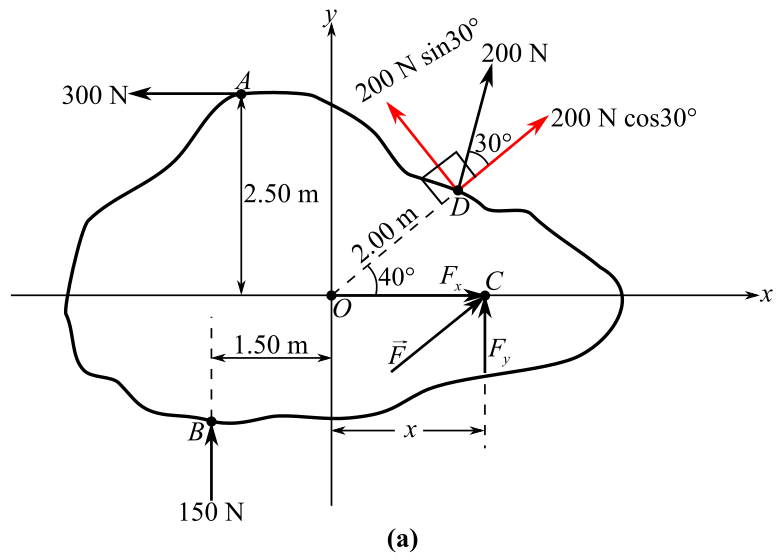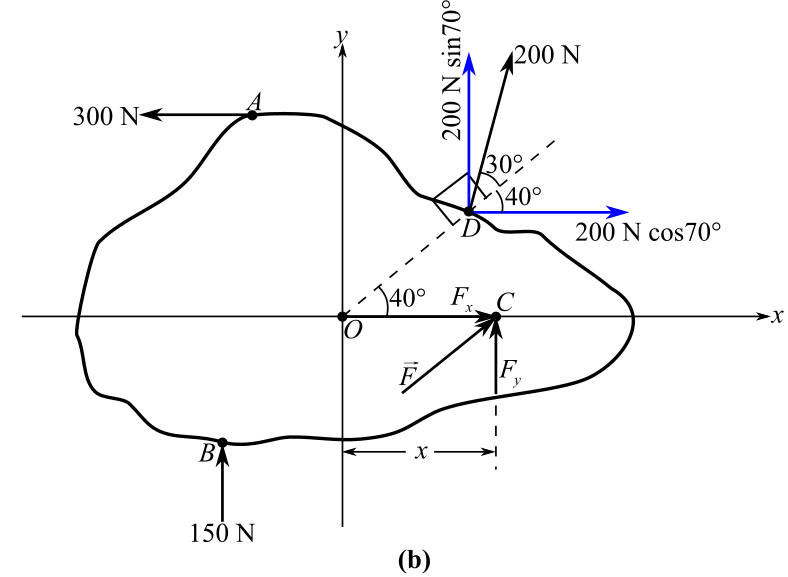
Concept explainers
An object is subjected to the forces shown in Fig. 5-25. What single force F applied at a point on the x-axis will balance these forces leaving the object motionless? (First find its components, and then find the force.) Where on the x-axis should the force be applied? Notice that before F is applied there is an unbalanced force with components to the left and upward.
![Chapter 5, Problem 36SP, 5.36 [III] An object is subjected to the forces shown in Fig. 5-25. What single force F applied at](https://content.bartleby.com/tbms-images/9781259587399/Chapter-5/images/87399-5-36sp-question-digital_image123.png)
Fig. 5-25
The magnitude of the applied force and direction of that force on the
Answer to Problem 36SP
Solution:
Explanation of Solution
Given data:
Refer to theFigure
Formula used:
From the parallelogram law of vector addition, if the expression of resultant force is written as
The magnitude of
Here,
The direction of
Write the expression for the first condition of force equilibrium:
Here,
Write the expression for torque:
Here,
Explanation:
Draw the free body diagram of the system:

In the above diagram,
Refer the above figure, recall the expression of torque:
Apply the equation for torque at point
Further solving the equation for
Draw the free body diagram of the system when resolving the force of

In the above diagram,
Consider theFigure (b)and recall the expression for the first condition of the force’s equilibriumin the x-direction:
Consider the direction of the rightward forces to be positive and the direction of the leftward forces to be negative. Therefore,
Rewrite the expression for the first condition of force equilibrium in the y-direction.
Consider the direction of the upward forces to be positive and the direction of the downward forces to be negative. Therefore,
The negative sign shows the direction of the force is downward.
Recall the expression for the magnitude of the resultant force:
Substitute
Recall the expression for the direction of the resultant force:
Substitute
Rewrite equation(1)
Substitute
Conclusion:
The value of the horizontal force
Want to see more full solutions like this?
Chapter 5 Solutions
Schaum's Outline of College Physics, Twelfth Edition (Schaum's Outlines)
- A block of mass 4.20 kg is pushed up against a wall by a force P that makes an angle of θ = 50.0°angle with the horizontal as shown below. The coefficient of static friction between the block and the wall is 0.270.arrow_forwardA ramp is inclined at 5 degrees with the horizontal. A barrel weighing 6 kilograms is placed on the ramp. The coefficient of static friction between the barrel and the ramp is 0.65. A force is applied to the barrel perpendicular to the incline to prevent the barrel from sliding down the incline. a. find the normal force. b. find the applied force.arrow_forwardWhat is the magnitude of the static friction force required to keep a 2.00 kg block resting on an inclined plane at an angle 25 degrees? If the angle was increased, such that the incline plane was steeper, would the magnitude of the static friction force required to hold the block at rest increase, decrease, or stay the same?arrow_forward
- If a 2.89 kg object is placed on a horizontal surface, what is its magnitude of acceleration if the coefficient of kinetic friction is known to be 0.442 and an applied force of 37 N directed at an angle of -25.6 degrees relative to the +x direction acts on the object?arrow_forwardA 5kg crate is simultaneously acted upon by a force of 60N acting to the right that is parallel to the surface, and a force of 10N acting to the left, which makes a 30 degree angle with the horizontal. If the coefficient of kinetic friction is 0.15, then the magnitude of the acceleration of the crate is about _____ m/s2.arrow_forwardThe coefficient of static friction between a 2.0 kg box and a plane inclined 28° to the horizontal is 0.65. What maximum applied force can be exerted on the box without moving it?arrow_forward
- A crate remains stationary after it has been placed on aramp inclined at an angle with the horizontal. Which of the following statements must be true about the magnitude of thefrictional force that acts on the crate? (a) It is larger than theweight of the crate. (b) It is at least equal to the weight of thecrate. (c) It is equal to μsn. (d) It is greater than the componentof the gravitational force acting down the ramp. (e) It isequal to the component of the gravitational force acting downthe ramp.arrow_forwardIn about 1915, Henry Sincosky of Philadelphia suspended himself from a rafter by gripping the rafter with the thumb of each hand on one side and the fingers on the opposite side. Sincosky’s mass was 79 kg. If the coefficient of static friction between hand and rafter was 0.70, what was the least magnitude of the normal force on the rafter from each thumb or opposite fingers? (After suspending himself, Sincosky chinned himself on the rafter and then moved hand-over-hand along the rafter. If you do not think Sincosky’s grip was remarkable, try to repeat his stunt.)arrow_forwardYou are holding a book of mass 10.7 kg that is initially at rest against a vertical wall by exerting a force of magnitudeF Yb = 100.8 N at an angle of θ = 34.7 degrees, as indicated in the figure.If the coefficients of friction between the book and the wall are μs = 0.46 and μk = 0.36, find the magnitude of thefrictional force from the wall on the book.arrow_forward
- A block (mass = 200.00 g) is placed on an inclined plane 45 degrees from the horizontal. The coefficient of static and kinetic friction between the block and the plane are 0.54 and 0.35, respectively. What is the frictional force between the block and the plane?arrow_forwardA boy has stacked two blocks on the floor so that a 5.00kgblock is on top of a1.60kg block. If the coefficient of static friction between the two blocks is 0.400 and the coefficient of static friction between the bottom block and the floor is 0.220,with what minimum force should the boy push horizontallyon the upper block to make both blocks start to slide together along the floor?arrow_forwardAn object weighing 4.5kg originally suspended by a vertical cord is pulled by a horizontal force until the cord makes and angle of 60˚ with the vertical. Find (a.) the tension in the cord, and the (b) the magnitude of the horizontal force to keep the object in this position.arrow_forward
 College PhysicsPhysicsISBN:9781305952300Author:Raymond A. Serway, Chris VuillePublisher:Cengage Learning
College PhysicsPhysicsISBN:9781305952300Author:Raymond A. Serway, Chris VuillePublisher:Cengage Learning College PhysicsPhysicsISBN:9781285737027Author:Raymond A. Serway, Chris VuillePublisher:Cengage Learning
College PhysicsPhysicsISBN:9781285737027Author:Raymond A. Serway, Chris VuillePublisher:Cengage Learning

